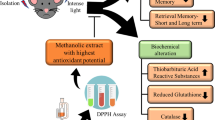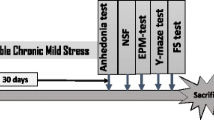Abstract
Rice bran oil (RBO) is an important product of rice bran. It is considered to be one of the most important nutritious oil due to its favorable fatty acid composition and unique composition of naturally occurring biologically active antioxidant compounds. This study was designed to monitor the effects of oral intake of RBO on stress response in rats. RBO was extracted using hexane. Rats were divided into Control and test (RBO-treated). RBO-treated rats were given 0.2 ml/day RBO for 6 weeks. Food intake and body weight changes were monitored weekly. After 6 weeks open field activity and Morris Water Maze (MWM) test were performed. Results showed that weekly cumulative food intake but not body weight were lower in RBO-treated rats during 1st to 5th week of treatment, which were normalized at the end of treatment. Exploratory activity of RBO-treated rats in an open field was increased. Spatial memory in Morris water maze was enhanced in RBO-treated than control rats. An episode of 2 h restraint stress decreased the 24 h food intake of both control and RBO-treated animals. Behavioral deficits were lower in RBO-treated rats. Exposure of 2 h restraint stress increased brain serotonin (5-hydroxytryptamine: 5-HT) metabolism. These increases were lower in RBO-treated restrained than their respective control animals. Serotonergic neurotransmitter mechanism is implicated in stress. The findings of the study show beneficial effects of RBO in learning and memory functions. Moreover, the study also highlights the attenuating effect of RBO on stress induced behavioral and neurochemical effects in rats.





Similar content being viewed by others
References
Adell A, Garcia-Marquez C, Armario A, Gelpi F (1988) Chronic stress increases serotonin and noradrenaline in rat brain and sensitizes their responses to a further acute stress. J Neurochem 50:1678–1681
Benado A.L. 2006. http//www.Patentstorm.us/patents/5783243description
Calviello G, Su HM, Weylandt KH, Fasano E, Serini S, Cittadini A (2013) Experimental evidence of ω-3 polyunsaturated fatty acid modulation of inflammatory cytokines and bioactive lipid mediators: their potential role in inflammatory, neurodegenerative, and neoplastic diseases. BioMed Res. Int. Volume 2013, Article ID 743171, 13 pages
Connor WE, Connor SL (1972) In: Hallgren B (ed) Diet and Prevention of Coronary Heart Disease and Cancer. Raven Press, New York, p 113
Fernstrom JD (1977) Effects of the diet on brain neurotransmitters. Metabolism 26:207–233
Fernstrom JD, Wurtman RJ, Hammarstrom-Wiklund Rand WM, Munro HN, Davidson CS (1979) Diurnal variations in plasma concentration of tryptophan, tyrosine and other neutral amino acids: effect of dietary protein intake. Am J Clin Nutr 32:1912–1922
Haider S, Khaliq S, Haleem DJ (2007) Enhanced serotonergic neurotransmission in the hippocampus following tryptophan administration improves learning acquisition and memory consolidation in rats. Pharmacol Rep 59:53–57
Haider S, Tabassum S, Ali S, Saleem S, Khan AK, Haleem DJ (2011) Age-related decreases in striatal DA produces cognitive deficits in male rats. J Pharm Nutri Sci 1(1):20–27
Haider S, Khaliq S, Tabassum S, Haleem DJ (2012) Role of Somatodendritic and postsynaptic 5-HT1A receptors on learning and memory functions in rats. Neurochem Res 37:2161–2166
Haider S, Saleem S, Perveen T, Tabassum S, Batool Z, Sadir S, Liaquat L, Madiha S (2014) Age-related learning and memory deficits in rats: role of altered brain neurotransmitters, acetylcholinesterase activity and changes in antioxidant defense system. Age. doi:10.1007/s11357-014-9653-0, Published online Ahead of print
Haleem DJ (1999) Serotonergic mechanism of antidepressant action and adaptation to stress. J Coll Phys Surg Pak 9:139–146
Haleem DJ, Perveen T (1994) Brain regional serotonin synthesis following adaptation to repeated restraint. NeuroReport 5:1785–1788
Haleem DJ, Jabeen B, Perveen T (1998) Inhibition of restraint-induced anorexia by injected tryptophan. Life Sci 63:503–512
Haleem DJ, Haider S, Perveen T, Inam Q, Kidwai IM, Haleem MA (2000) Hyperphagia and decreases of brain serotonin in rats fed freely on sugar rich diet for three weeks. Nutr Neurosci 3:399–405
Hansakul P, Srisawat U, Itharat A, Lerdvuthisopon N (2011) Phenolic and flavonoid contents of Thai rice extracts and their correlation withantioxidant activities using chemical and cell assays. J Med Assoc Thai Suppl 7:S122–130
Ikemoto A, Ohishi M, Sato Y, Hata N, Misawa Y, Fujii Y, Okuyama H (2001) Reversibility of n-3 fatty acid deficiency-induced alterations of learning behavior in the rat: level of n-6 fatty acids as another critical factor. J Lipid Res 42(10):1655–1663
Jabeen B, Badaruddin M, Ali R, Haleem DJ (2007) Attenuation of restraint-induced behavioral deficits and serotonergic responses by stabilized rice bran in rats. Nutr Neurosci 10(1/2):11–16
Jorgensen HS (2007) Studies on the neuroendocrine role of serotonin. Dan Med Bull 54(4):266–88
Juliano BO (1985) Rice: Chemistry and Technology. American Association of Cereal Chemists. St. Paul, MN
Keeney A, Jeesop DS, Harbuz MS, Marsden CA, Hogg S, Blackburn-Munro RE (2006) Differential effects of acute and chronic social defeat stress on hypothalamic-pituitary adrenal axis function and hippocampal serotonin release in mice. J Neuroendocrinol 18(5):330–338
Kennett GA, Chaouloff F, Marcou M, Curzon G (1986) Female rats are more vulnerable than male in an animal model of depression: the possible role of serotonin. Brain Res 382:416–421
Khuwijitjaru P, Yuenyong T, Pongsawatmanit R, Adachi S (2009) Degradation kinetics of gamma-degradation kinetics of gamma-oryzanol in antioxidant-stripped rice bran oilduring thermal oxidation. J Oleo Sci 58(10):491–497
Kim MK, Yu WK, Kang DH, Suh JH (2002) Anti-stress and anti-fatigue effect of fermented rice bran. Phytother Res 16:700–702
Leonard BE (2005) The HPA and immune axis in stress. The involvement of the serotonergic system. Eur J Psychiat 20(Suppl 3):S302–306
Meltzer H (1989) Serotonergic dysfunction in depression. Br J Psychiat 155:25–31
Mishra R, Sharma HK, Sarkar BC, Singh C (2012) Thermal oxidation of rice bran oil during oven test and microwave heating. J Food Sci Technol 49(2):221–227
Nesic J, Duka T (2008) Effects of stress on emotional reactivity in hostile heavy social drinkers following dietary tryptophan enhancement. Alcohol Alcohol 43(2):151–162
Nicolosi RJ, Goldin B, Schaefer EJ (1994) Rice bran oil consumption and plasma lipid levels in moderately hypercholesterolemic humans. Arterioscl Thromb 14:549–546
Paez X, Leibowitz SF (1993) Changes in extracellular PVN monoamines and macronutrient intake after idazoxan or fluoxetine injection. Pharmacol Biochem Behav 46(4):933–41
Pham J, Porter J, Svec D, Eiswirth C, Svec F (2000) The effect of dehydroepiandrosterone on zucker rats selected for fat food preference. Physiol Behav 70(5):431–441
Posuwan J, Prangthip P, Leardkamolkarn V, Yamborisut U, Surasiang R, Charoensiri R, Kongkachuichai R (2013) Long-term supplementation of high pigmented rice bran oil (Oryza sativa L.) on amelioration of oxidative stress and histological changes in streptozotocin-induced diabetic rats fed a high fat diet; riceberry bran oil. Food Chem 138(1):501–508
Rana P, Vadhera S, Soni G (2004) In vivo antioxidant potential of rice bran oil (RBO) in albino rats. Indian J Physiol Pharmacol 48(4):428–436
Rogers RF, Paton JF, Schwaber JS (1993) NTS neuronal responses to arterial pressure and pressure changes in the rat. Am J Physiol 265(6 Pt 2):R1355–1368
Rukmini C, Raghuram TC (1991) Nutritional and biochemical aspects of the hypolipidemic action rice bran oil. A Rev J Am Coll Nutr 10:593–601
Saunders RM (1985) Rice bran: composition and potential food uses. Food Rev Int 1:465–495
Sharma RD, Rukmini C (1987) Hypocholesterolemic activity of unsaponifiable matter of rice bran oil. Ind J Med Res 85:278–281
Sierra S, Lara-Villoslada F, Olivares M, Jiménez J, Boza J, Xaus J (2005) Increased immune response in mice consuming rice bran oil. Eur J Nutr 44(8):509–516
Sugano M, Tsuji E (1997) Rice bran oil and cholesterol metabolism. J Nutr 127(3):521S–524S
Tsuji M, Takeuchi T, Miyagawa K, Takeda H (2012) Role of brain 5-HT7 receptors as a functional molecule involved in the development of stress adaptation. Jap J Psychopharmacol 32(4):187–93
Tyagi K, Ansari MA, Tyagi S, Tyagi A (2012) A novel process for physically refining rice bran oil through degumming. Advan Appl Sci Res 3(3):1435–1439
Van Hoed V, Vila Ayala J, Czarnowska M, De Greyt W, Verhe R (2011) Erratum to: optimization of physical refining to produce rice bran oil with light color and high oryzanol content. J Am Oil Chem Soc 88:1083
Xu Z, Hua N, Godber S (2001) Antioxidant activity of tocopherols, tocotrienols and γ-orynazol components from rice bran against cholesterol oxidation accelerated by 2, 2-azobis (2-methylpropionamide) dihydrochloride. J Agr Food Chem 49:2077–2081
Zare K, Tabatabaei SRF, Shahriari A, Jafari RA (2011) Effect of butter and sesame oils on avoidance memory of diabetic rats. Iran J Diab Obesity 3(2):65–70
Acknowledgments
This work was supported by a grant from Higher Education Commission (HEC) Government of Pakistan.
Author information
Authors and Affiliations
Corresponding author
Rights and permissions
About this article
Cite this article
Mehdi, B.J., Tabassum, S., Haider, S. et al. Nootropic and anti-stress effects of rice bran oil in male rats. J Food Sci Technol 52, 4544–4550 (2015). https://doi.org/10.1007/s13197-014-1489-1
Revised:
Accepted:
Published:
Issue Date:
DOI: https://doi.org/10.1007/s13197-014-1489-1




